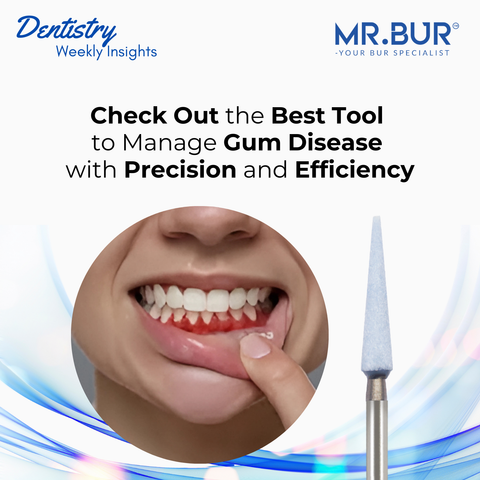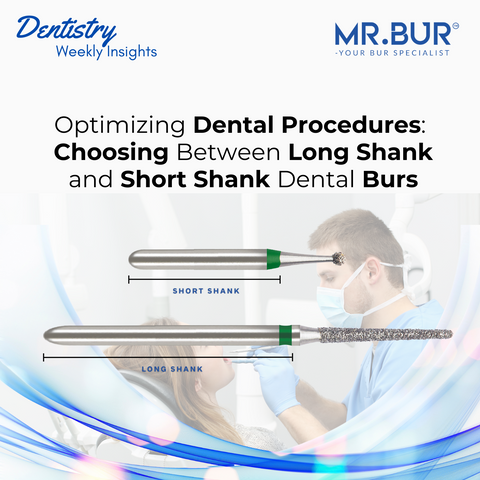In restorative dentistry, the choice of dental bur can significantly impact the success of the procedure. Among the most commonly used are the 330 carbide burs and 330 diamond burs. Both burs share a pear-shaped design, making them essential tools for creating undercuts and retentive cavity outlines. However, they differ in terms of material, application, and the type of restorative outcomes they achieve. In this article, we’ll explore the use of these burs in various dental procedures, highlighting their unique benefits and clinical applications.
Understanding the 330 Bur Design
330 bur is defined by its pear-shaped head, which is ideal for retentive cavity preparations. The shape allows for the creation of rounded internal angles that distribute stress more evenly, reducing the risk of restoration failure. This design is effective in both caries removal and cavity refinement, making it a versatile tool in restorative dentistry.
Class I Cavity Preparation with 330 Carbide Burs
What Is Class I Cavity Preparation?
Class I cavity preparation involves removing decay from the occlusal surfaces of posterior teeth. The primary goal is to eliminate decay while maintaining as much of the healthy tooth structure as possible. This requires precision and efficiency, making the 330 carbide bur a top choice for this procedure.
Application of 330 Carbide Bur
330 carbide bur is known for its aggressive cutting action, which makes it ideal for quickly accessing and removing decayed dentin. Here’s how it is used:
- Initial Decay Removal: Start by using the Mr. Bur 330 carbide bur in a high-speed handpiece to access the carious lesion. Its sharp cutting edges make quick work of soft and moderate caries, allowing for rapid removal of decayed tissue.
- Creating Retentive Undercuts: The bur’s pear shape naturally creates undercuts, essential for retaining the restorative material. Its short head design allows for better control, making it easier to navigate the occlusal surface without damaging adjacent structures.
- Heat Management: Mr. Bur 330 carbide bur generates less heat during cutting, reducing the risk of pulpal damage. However, water irrigation is still recommended to ensure patient comfort and to clear debris.
Clinical Tips for Class I Preparation
- Use a light, sweeping motion with Mr. Bur 330 carbide bur to create a conservative cavity outline.
- Keep the bur at a consistent angle to maintain cavity depth and shape.
- Apply water cooling throughout the procedure to enhance visibility and minimize heat buildup.
Follow-Up Procedure: Occlusal Reduction & Restoration
After completing the Class I cavity preparation, occlusal reduction may be necessary to ensure the final restoration sits flush with the occlusal plane. Following this, various restorative materials such as composite resin, amalgam fillings, or onlays can be placed to restore the tooth's functionality.
Class II Cavity Preparation with 330 Diamond Burs
What Is Class II Cavity Preparation?
Class II cavity preparation targets decay in the interproximal surfaces of posterior teeth, requiring more intricate shaping compared to Class I cavities. The procedure demands both effective decay removal and precise cavity shaping to ensure proper bonding and longevity of the restoration.
Application of 330 Diamond Bur
330 diamond bur excels in this scenario, particularly during the finishing stage of cavity preparation:
- Refining Enamel Walls: After initial decay removal, switch to Mr. Bur 330 diamond bur to refine the cavity walls. Its diamond coating offers finer cutting, making it ideal for smoothing and contouring enamel surfaces, which is crucial for creating a clean bonding surface.
- Proximal Box Shaping: The bur’s abrasive nature allows for effective finishing of the proximal box, ensuring smooth cavity walls that enhance composite adhesion. Mr. Bur 330 diamond bur can also create bevels on the enamel edge, improving the bond strength of the restoration.
- Water Cooling for Comfort: The 330 diamond bur tends to generate more heat than carbide burs, so water irrigation is necessary to prevent overheating and improve patient comfort.
Clinical Tips for Class II Preparation
- Use Mr. Bur 330 diamond bur with a high-speed handpiece for optimal finishing results.
- Apply gentle pressure to avoid removing excess enamel, focusing on achieving a smooth surface for better bonding.
- Ensure thorough water irrigation to maintain a clear working field and prevent discomfort.
Class V Lesion Treatment Using 330 Burs
What Are Class V Lesions?
Class V lesions are located at the gingival third of the tooth, often caused by factors like abrasion, erosion, or root exposure. Treatment involves precise removal of decayed tissue and preparation of the dentin and enamel surfaces to accommodate the restorative material.
Using 330 Carbide Bur for Initial Access
330 carbide bur is used to initiate access to the lesion:
- Its small head size and cutting efficiency make it ideal for working near the gingival margin.
- The carbide bur’s ability to cut rapidly and with precision helps create a conservative cavity outline, preserving healthy dentin.
Using 330 Diamond Bur for Finishing
After decay removal, switch to the 330 diamond bur for refining the cavity:
- Use Mr. Bur 330 diamond bur to smooth the internal cavity walls and bevel the enamel edges, ensuring better retention of the restorative material.
- The fine grit of the diamond bur helps create a smooth finish, reducing plaque accumulation around the restoration and improving long-term oral health outcomes.
Clinical Tips for Class V Lesion Treatment
- Use a gentle touch with Mr. Bur 330 carbide bur to avoid damaging the gingival tissue.
- Follow up with Mr. Bur 330 diamond bur to achieve a polished, well-defined margin for improved bonding.
Follow-Up Procedure: Composite Resin or Glass Ionomer Filling
Once the lesion is prepared, use composite resin or glass ionomer cement to fill the cavity. These materials offer excellent aesthetic and functional outcomes, especially in the cervical region.
Advanced Restorative Procedures After Cavity Preparation
Occlusal Reduction
After initial cavity preparation, occlusal reduction might be required to ensure that the final restoration sits flush with the opposing tooth. This step is crucial for achieving proper occlusion and preventing excessive wear on the restoration.
Restorative Options After Preparation
Depending on the size and depth of the cavity, the following restorative options can be pursued:
- Direct Filling: For smaller cavities, composite resin or amalgam is used to restore the tooth structure.
- Onlays and Inlays: For larger cavities that do not compromise the cusps, onlays or inlays can be fabricated to restore the tooth.
- Crowns: If the tooth structure is extensively damaged, full crowns may be necessary to provide full coverage and protect the remaining structure.
- Implants: In cases where the tooth is non-restorable, implant placement can be considered after extraction and healing.
To have more information about restorative, read Which Carbide Burs You Should Use for Dental Restoration.
Conclusion
Mr. Bur 330 carbide and diamond burs are indispensable in restorative dentistry, each serving specific roles in cavity preparation, decay removal, and finishing. By understanding their unique benefits and applications across various dental procedures, dentists can achieve optimal results while preserving tooth structure and enhancing patient comfort. Integrating both burs into your practice ensures efficiency, precision, and improved clinical outcomes.
MR. BUR US provides a wide range of dental burs globally.
Explore More:
Why Every Dentist Needs to Understand G.V. Black’s Caries Classification
Diamond Burs, Carbide Burs, Surgical & Lab Use Burs, Endodontic burs, IPR Kit, Crown Cutting Kit, Gingivectomy Kit, Root Planning Kit, Composite Polishers, High Speed Burs, Low Speed Burs
Subscribe our newsletter now!






